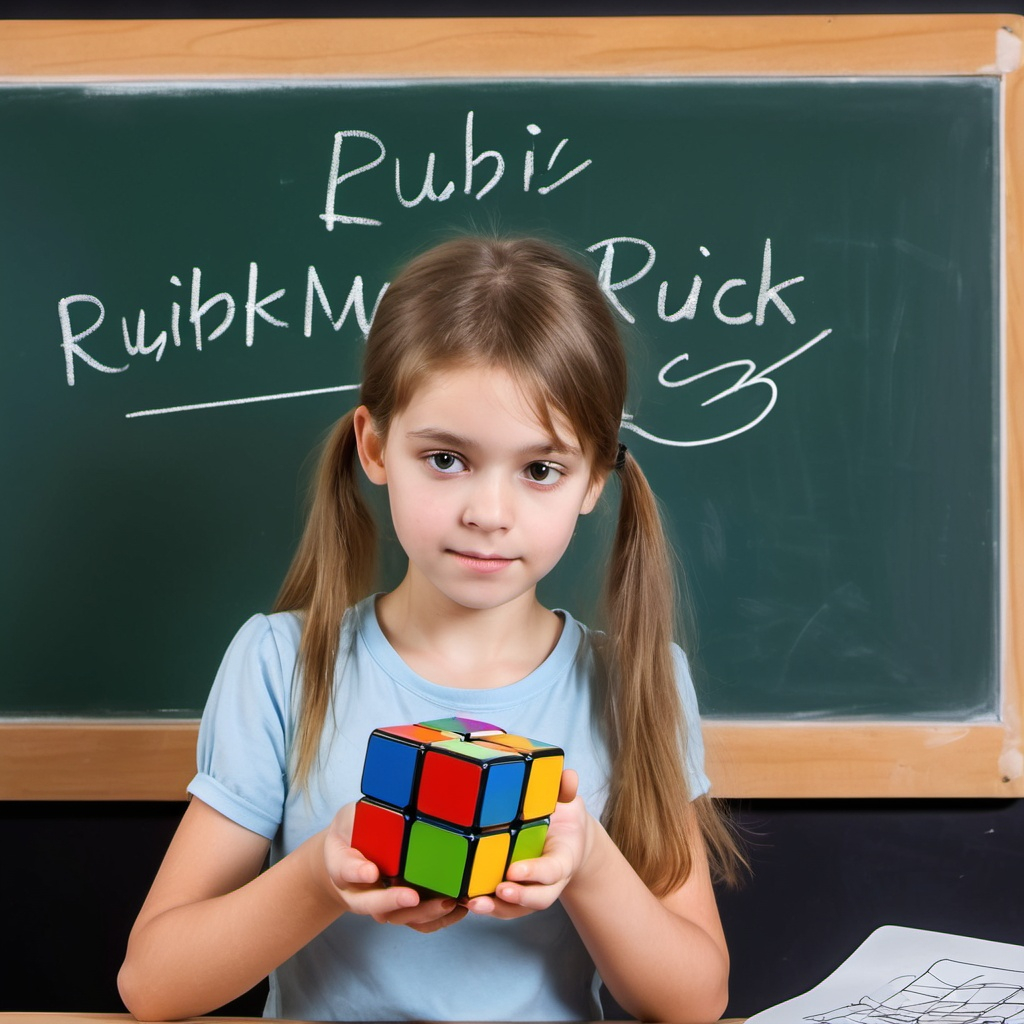Using the famous three-dimensional puzzle, students in 6th grade in CEIP Mestre Martínez Alonso in Pontevedra developed memory, teamwork, and reading comprehension, among others. In this presentation, teacher Elvira Fernández shows how all these values are acquired in a participative and playful manner.
The world-renowned Rubik’s Cube is the best-selling 3D puzzle in the world, celebrating its 50th anniversary! Invented by Hungarian sculptor and architect Ernő Rubik, the puzzle tests dexterity, logical thinking, and the ability to focus one’s concentration significantly to align all six sides of color. However, further than a mere game, the cube opens up many learning opportunities, as we have found in activities linked to school curriculum criteria, ranging from mathematics, teamwork, and appreciation for art.

1. Mathematical Skill and Geometry
This activity on the Rubik’s Cube started with an introduction to polyhedra, where students were led to understand the world as full of shapes with faces, edges, and vertices. The cube was a tangible example of that, further divided into smaller parts known as “cubies.” Then, the children were introduced to how the inner structure of the cube is organized and how cubies can be rearranged by controlled rotations. They used manipulative geometry lessons, viewing shapes and deliberating over such concepts as symmetry, transformation, and angles. The cube provided a way to visualize mathematics; therefore, offering students a more hands-on approach.
2. Introduction to Mathematical Algorithms and Spatial Perception
Each of the algorithms necessary to solve the Rubik’s Cube was unique and included specific notation, using the letters U, D, L, R, F, and B-which represent Up, Down, Left, Right, Front, and Back of the cube. These abbreviations provided the students with one simple language that could be easily memorized in which moves should be performed in order to solve the puzzle. In this regard, students are able to learn the turning of the appropriate side of the cube clockwise or counterclockwise.
By practicing such algorithms as “R, B’, F, L’, D, “, students developed spatial awareness in their mind by “thinking” through what the moves would do to the cube. It is intuitive, in that one should get a feeling of space and an idea of how every twist and turn changes the orientation of a component in space. This aspect of the learning process combined problem-solving and step-by-step reasoning, therefore strongly reinforcing critical thinking.
In addition to mathematics, we also incorporated some reading comprehension activities that were designed to promote collective intelligence. Students worked on a visual text and a video tutorial creatively sequenced according to Universal Design for Learning (UDL) theory in order to suit different learning preferences. This activity was framed as a collaborative task in which students read, discussed, and interpreted instructions at each skill level, encouraging one another to master the cube.
We fragmented this visual text into workable chunks, where different algorithms were explained and then gradually practiced. It provided the students with an opportunity to break down complex information into more understandable fragments. While learning about one algorithm if they could grasp it, that feeling of accomplishment led to venturing on to the next, setting off a self-reinforcing cycle of learning and engagement.
4. Digital Competence
This way, it made it a more modern and efficient way of learning. I put the instructional text online in Moodle, our virtual learning platform. This made it digital for the students; that is to say, lesser usage of paper and therefore greener by saving the trees to make papers. Still, for those students who learn best from physical, hands-on materials, printed copies were made. In this way, we encouraged digital literacy, showing them how to find their way around the online resources, participate in virtual classrooms, and ways in which they might generally use technology to their advantage in education.
5. Teamwork and Planning
The activity that involved the Rubik’s Cube encompassed two interactive sessions in which, during these sessions, three out of seven foundation steps for beginners were learned, as well as the algorithms that needed to be used in order to solve each phase of the puzzle. By pursuing this approach to collaboration, a sense of teamwork and interdependence was fostered, whereby students who knew the Rubik’s Cube automatically became the mentees of their colleagues.
They strategized, shared tactics, and rejoiced in each other’s triumphs. This greatly encouraged the students who did poorly and generally increased the sense of cohesion within the class. What was to be a challenge-the solving of the puzzle-became a venue for students to express leadership, communication, and support for one another.
6. Improved Motor Skills and Memory
While manipulating the cube physically, the fine motor skills of the students improved; their hands moved in precise, coordinated ways. Repeatedly practicing algorithms not only trained their muscles but also reinforced memory-in a way, to remember sequences of moves that would take them further in the activity. It was fun, too-exercising the hands and brains together by seamlessly melding physical and cognitive learning.
7. Promoting Visual and Plastic Arts Culture
The Rubik’s Cube has inspired unique art forms, such as “Rubik Cubism” or “RubiKismo,” which incorporate the cube’s colorful, block-like patterns into visual masterpieces. We could then link this artistic style to other techniques, such as pointillism, to further investigate how artists use geometric patterns and colors to create visual illusions. We encouraged students to think creatively-about the cube not just as a puzzle but as an artistic medium.
They were even given an opportunity to try to design some artwork inspired by the Rubik’s Cube and appreciated the way in which math and art can interplay. This developed an appreciation for the fine arts and a realization that many mathematical concepts have aesthetic applications, as well.
8. Other Skills Developed
Besides such skills, patience, persistence, and the capability of profound focusing have been developed. They exercised selected and sustained attention-to cover a specific goal among all distractions that always appear while solving some problem or another. These emotional and psychological skills are important in the prospects of both academic success and personal development, which prepare students for the challenges that are expected to be faced inside and outside the classroom.
9.** Critical Thinking and Problem-Solving**
The Rubik’s Cube develops critical thinking and problem-solving in matters that may be complicated. Any move one makes illustrates how necessary careful deliberation and analysis are to the effect that the puzzle will lead to. Students need to strategize in advance and think several steps ahead, thus creating a great ability for evaluation, the ability to anticipate any further challenges, and knowing how to alter their approach when it would be needed. This is a very good transfer into real-life situations where solving problems and logical thinking are necessary.
10. Resilience and Emotional Intelligence
The Rubik’s Cube solving could sometimes be frustrating when that is not exactly what happened. By taking up the challenge, they come to learn how to monitor their own emotions, exercise self-regulation of themselves, and recover from those tumbles. They feel the process of perseverance and a positive mindset leading eventually to success, building emotional intelligence and the capability to face obstacles resiliently. The students also learn to celebrate small victories all their way; these help them gain more confidence in themselves.
11. Leadership and Peer Teaching
Students who quickly learn to solve the Rubik’s Cube often become natural leaders by sharing knowledge with peers and classmates. This would give them an opportunity to engage in leadership roles like guiding peers, explaining concepts clearly, and showing patience and empathy. This type of peer teaching reinforcement supports their understanding and strengthens the community of the class because the students work together and build each other up in understanding.
12. Attention to detail
Successfully solving a Rubik’s Cube requires an eye for detail. Every single piece, its position, color, and configuration with each movement, needs attention by the student. This sense of precision helps sharpen their attention to detail-a skill useful both at school and in real life. It will also teach them to work cautiously and not make careless mistakes.
In conclusion, the use of the Rubik’s Cube within a classroom setting has proved to be an incredibly effective tool regarding the active involvement of students in developing a wide array of skills. Enhancing mathematical understanding and spatial awareness, increasing the spirit of teamwork, improving reading comprehension, and even instilling artistic appreciation-the cube makes traditional learning hands-on and interactive.
These activities sharpen not only cognitive skills like memory and concentration but also build up emotional resilience and patience. In this way, we have integrated the Rubik’s Cube into our lessons, building up a resourceful and multirelevant approach that motivates students, fosters collaboration, and helps them to tackle complex problems with creativity and perseverance. The impact goes beyond solving the puzzle in question; it instills a lifelong enthusiasm for learning and a deeper realization of just how linked our knowledge and skills really are.

